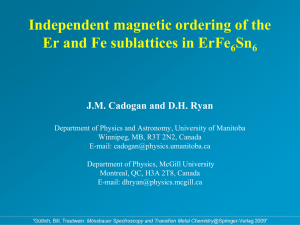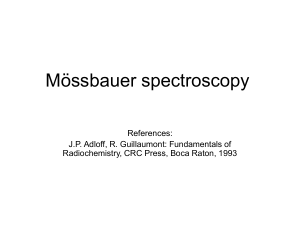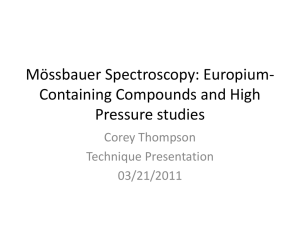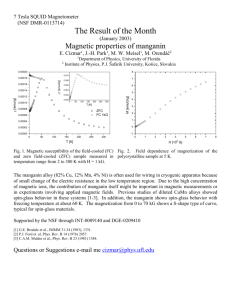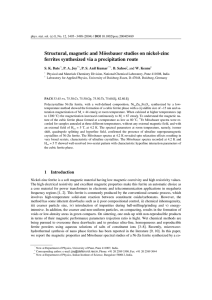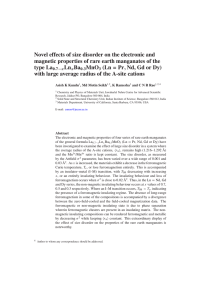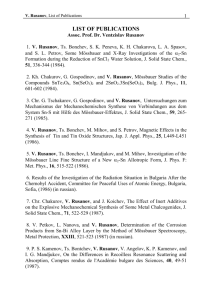View
advertisement
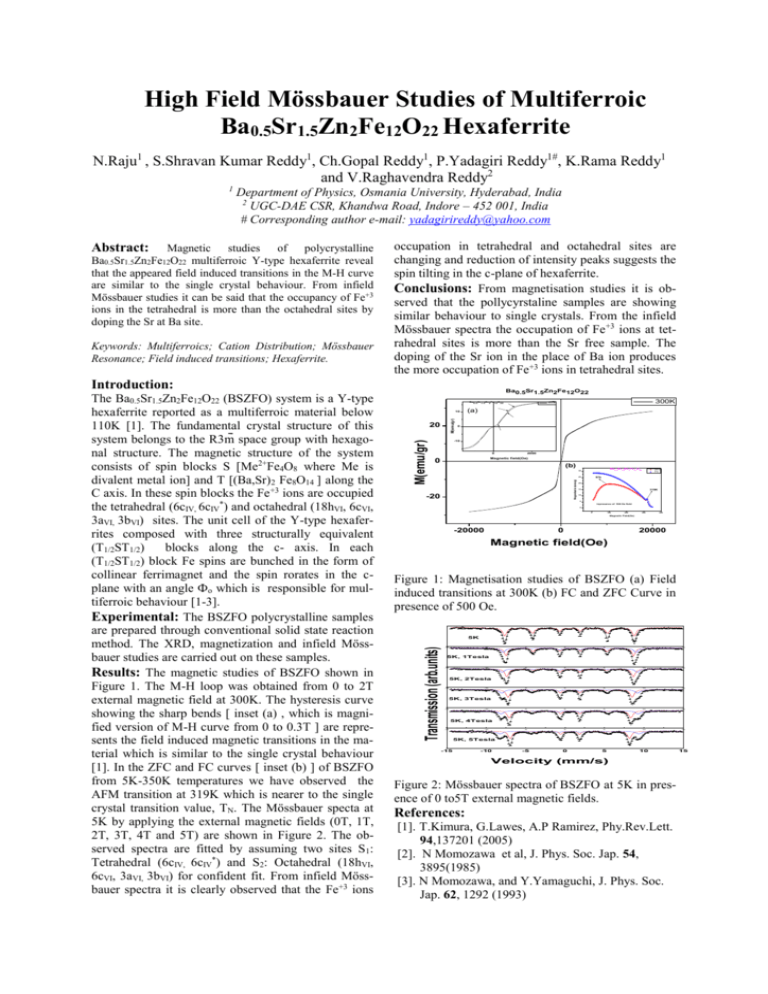
High Field Mössbauer Studies of Multiferroic Ba0.5Sr1.5Zn2Fe12O22 Hexaferrite N.Raju1 , S.Shravan Kumar Reddy1, Ch.Gopal Reddy1, P.Yadagiri Reddy1#, K.Rama Reddy1 and V.Raghavendra Reddy2 1 Department of Physics, Osmania University, Hyderabad, India 2 UGC-DAE CSR, Khandwa Road, Indore – 452 001, India # Corresponding author e-mail: yadagirireddy@yahoo.com Abstract: Magnetic studies of polycrystalline Ba0.5Sr1.5Zn2Fe12O22 multiferroic Y-type hexaferrite reveal that the appeared field induced transitions in the M-H curve are similar to the single crystal behaviour. From infield Mössbauer studies it can be said that the occupancy of Fe+3 ions in the tetrahedral is more than the octahedral sites by doping the Sr at Ba site. Keywords: Multiferroics; Cation Distribution; Mössbauer Resonance; Field induced transitions; Hexaferrite. occupation in tetrahedral and octahedral sites are changing and reduction of intensity peaks suggests the spin tilting in the c-plane of hexaferrite. Conclusions: From magnetisation studies it is observed that the pollycyrstaline samples are showing similar behaviour to single crystals. From the infield Mössbauer spectra the occupation of Fe +3 ions at tetrahedral sites is more than the Sr free sample. The doping of the Sr ion in the place of Ba ion produces the more occupation of Fe+3 ions in tetrahedral sites. Introduction: Ba0.5Sr1.5Zn2Fe12O22 Ba0.5 Sr1.5 Zn 2Fe12O 22 M(emu/gr) 10 300K 300k (a) 0 -10 0 2000 Magnetic field(Oe) 0 (b) Ba0.5Sr1.5Zn2Fe12O22 30 -20 ZFC FC 97k 25 Magnetization(emu/g) M(emu/gr) 20 20 15 319K 10 5 Inpresence of 500 Oe field 0 0 100 200 300 400 Magnetic Field(Oe) -20000 0 20000 Magnetic field(Oe) Figure 1: Magnetisation studies of BSZFO (a) Field induced transitions at 300K (b) FC and ZFC Curve in presence of 500 Oe. 5K Transmission (arb.units) The Ba0.5Sr1.5Zn2Fe12O22 (BSZFO) system is a Y-type hexaferrite reported as a multiferroic material below 110K [1]. The fundamental crystal structure of this system belongs to the R3m space group with hexagonal structure. The magnetic structure of the system consists of spin blocks S [Me2+Fe4O8 where Me is divalent metal ion] and T [(Ba,Sr)2 Fe8O14 ] along the C axis. In these spin blocks the Fe+3 ions are occupied the tetrahedral (6cIV, 6cIV*) and octahedral (18hVI, 6cVI, 3aVI, 3bVI) sites. The unit cell of the Y-type hexaferrites composed with three structurally equivalent (T1/2ST1/2) blocks along the c- axis. In each (T1/2ST1/2) block Fe spins are bunched in the form of collinear ferrimagnet and the spin rorates in the cplane with an angle Фo which is responsible for multiferroic behaviour [1-3]. Experimental: The BSZFO polycrystalline samples are prepared through conventional solid state reaction method. The XRD, magnetization and infield Mössbauer studies are carried out on these samples. Results: The magnetic studies of BSZFO shown in Figure 1. The M-H loop was obtained from 0 to 2T external magnetic field at 300K. The hysteresis curve showing the sharp bends [ inset (a) , which is magnified version of M-H curve from 0 to 0.3T ] are represents the field induced magnetic transitions in the material which is similar to the single crystal behaviour [1]. In the ZFC and FC curves [ inset (b) ] of BSZFO from 5K-350K temperatures we have observed the AFM transition at 319K which is nearer to the single crystal transition value, TN. The Mössbauer specta at 5K by applying the external magnetic fields (0T, 1T, 2T, 3T, 4T and 5T) are shown in Figure 2. The observed spectra are fitted by assuming two sites S1: Tetrahedral (6cIV, 6cIV*) and S2: Octahedral (18hVI, 6cVI, 3aVI, 3bVI) for confident fit. From infield Mössbauer spectra it is clearly observed that the Fe+3 ions -15 -10 -5 0 5 10 15 -5 0 5 10 15 -5 0 5 10 15 -5 0 5 10 15 -5 0 5 10 15 -5 0 5 10 15 5K, 1Tesla -15 -10 5K, 2Tesla -15 -10 5K, 3Tesla -15 -10 5K, 4Tesla -15 -10 5K, 5Tesla -15 -10 Velocity (mm/s) Figure 2: Mössbauer spectra of BSZFO at 5K in presence of 0 to5T external magnetic fields. References: [1]. T.Kimura, G.Lawes, A.P Ramirez, Phy.Rev.Lett. 94,137201 (2005) [2]. N Momozawa et al, J. Phys. Soc. Jap. 54, 3895(1985) [3]. N Momozawa, and Y.Yamaguchi, J. Phys. Soc. Jap. 62, 1292 (1993)
